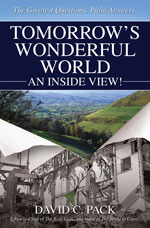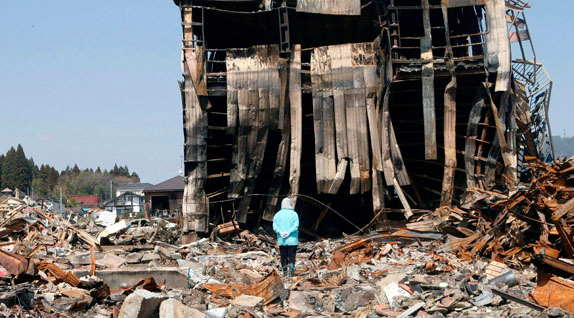 STR/AFP/Getty Images
STR/AFP/Getty Images
Article
What can the world learn from the nation’s ability to accept natural disasters as a normal part of life?
Learn the why behind the headlines.
Subscribe to the Real Truth for FREE news and analysis.
Subscribe NowJapan thought it was prepared. It had conducted drills and planned evacuation routes. Its people knew what to do when facing calamity.
So when the Tohoku-Pacific Ocean earthquake hit at 2:46 p.m. on March 11, it was at first considered just another temblor. Internet videos show residents appearing to shrug off the shaking, continuing to calmly walk through airports, talk on cellphones, window shop, work at their desks, attend meetings, or drum on computers.
Yet as the shaking continued, they became more concerned. Computers spun off desks. Mantelpieces tipped over. Electricity shut off, leaving employees in the dark. Workers who were initially filmed nervously laughing about the quake’s first movements slowly stopped smiling. People realized it might be the “big one” they had anticipated for years.
Panic soon set in. Skyscrapers swayed violently, knocking down residents. Store items flew off shelves. Water pipes burst, causing flooding. Fires ignited across Tokyo. Sections of the ground ripped open, squeezing water to the surface and causing mini-geysers in grassy park knolls. Roads split in half, forming huge chasms. Even whole buildings crashed to the ground.
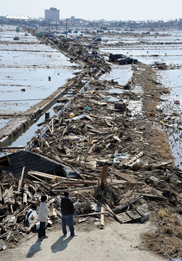 STR/AFP/Getty Images
STR/AFP/Getty Images
By minute five, most people had run to an area where they felt safe—ducking beneath desks, bracing in doorways, or sprinting into nearby streets. As workers stumbled out of buildings, it was apparent this was no ordinary quake.
The largest mega-temblor in the nation’s history and fourth-largest in recorded history, the 9.0-magnitude earthquake occurred off the northeastern coast of Honshu, on mainland Japan. It shifted the nation nearly 10 feet, dropping parts of its coast by more than a yard.
“You could tell this was different instantly from other little tremors we’ve had before,” an American bystander told CNN. “It just picked up in intensity.”
Surrounded by debris, injuries, buildings on fire, aftershocks, fear and death, many thought the worst was over. Little did they know the ordeal had just begun.
Wall of Water
The powerful earthquake and ensuing aftershocks meant one thing: a tsunami was most likely barreling toward Japan’s coastline.
Roughly 62 miles northeast out to sea, a massive wave was already forming. Close to the epicenter, sailors felt a sharp lift in the water. Not long afterward, shockwaves estimated at 3.7 miles per second began moving inland.
People reacted with a mixture of horror and disbelief. As throngs of citizens toting belongings scrambled to higher ground, shouts of “The tsunami is coming!” could be heard.
A National Geographic compilation of amateur videos showed people fleeing. “This is the end,” one man who saw the waves approaching wailed. Another despairingly said, “Everything is coming to an end.”
Sirens sounded warnings, but for those not already on high ground, it was too late. The waves raced toward Japan’s coastline, sending 10 billion tons of water—three-story tall waves—barreling onto the seashore.
Over the thunderous rushing water, some in high-rise buildings cried out to those below, desperately trying to warn them, but to no avail. Others worried about their belongings: “Stop water,” one man commented. “Please don’t take my car.”
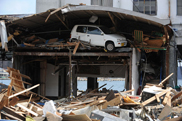 Roslan Rahman/AFP/Getty Images
Roslan Rahman/AFP/Getty Images
Miyagi prefecture was engulfed by coal-black water. Vehicles on nearby highways were swiped by raging waves. Caravans of floating vans crashed into town landmarks and the rampaging current splintered thousands of homes. Huge clouds of smoke and dust blanketed the area.
In a matter of seconds, the wall of debris mowed over farmland, sweeping away vehicles, trains, homes, people, animals and boats as far as six miles inland. Towns and cities were obliterated. Large commercial boats, pushed deep inland, were shoved between broken wooden buildings and crushed metal. Thousands were taken to unmarked watery graves, often in cars unable to outrun the barrage.
Miyako city, which has 33-foot sea walls, warning sirens, and routinely conducts tsunami drills, was completely destroyed. The force of the tsunami easily breached its coastal defenses. Several structures, including an oil refinery outside Tokyo, were set ablaze, creating islands of fire atop the inundated terrain.
Tsunami waves also struck the Fukushima Daiichi nuclear plant, which had three reactors in operation. Each one experienced hydrogen explosions: one blast injured 11 workers and another reportedly breached the inner containment vessel—causing a dangerous situation for surrounding areas. As a result, government officials imposed an 18-mile radius no-fly zone around the plant and ordered all residents within approximately 20 miles of the area to evacuate—another consequence of the growing disaster.
Ripple Effects
As the tsunami receded, people watched with horror as family members, friends, houses, factories, pets and belongings were dragged to sea. Devastated onlookers stood over broken cities, powerless to stop the outgoing waves.
“It’s over,” one survivor on the National Geographic compilation video said. “Everything is gone.” Another said, “I give up.”
In certain areas, the water did not recede, leaving people stranded on small debris islands, or waving homemade white flags from building windows in hope of aerial rescue. Where they could, bewildered townspeople combed through snow and mud, hoping to find loved ones.
 JiJi Press/AFP/Getty Images
JiJi Press/AFP/Getty Images
Those sifting through wreckage had to contend with the fear of additional tsunamis. During the week following the historic earthquake, the country experienced more than 500 aftershocks, several stronger than 7.0-magnitude. But with buildings in some towns completely destroyed, people had no place to hide.
As of this writing, more than 14,785 people have been confirmed dead, and 10,271 have been reported missing.
The tragedy has also brought economic calamity.
“The Tohoku quake, tsunami, and still unfolding nuclear crisis are clearly having a traumatic effect on Japan, the worst crisis Japan has suffered since World War II,” Bill Witherell, chief global economist for consulting firm Cumberland Advisors, wrote. He said Tokyo’s stock exchange “Nikkei 225 dropped 1.7% in the 14 minutes the market remained open after the quake…”
Insurance companies have been overwhelmed with claims.
“Losses in the $30 to $50 billion range would make the Japanese earthquake the second-most expensive event in the history of the global insurance industry,” CBC News stated.

The auto industry has been particularly hard-hit, with vehicle exports falling 27.8 percent due to power shortages and interrupted deliveries. Financial analysts predict it could take months before exports return to normal production levels.
On top of this, health authorities are concerned about a spike in the pneumonia rate of senior citizens, which is now five times higher than pre-quake levels. The majority of those who lost their homes were over 60 years old, and the stress of living in close quarters in makeshift shelters is causing their health to deteriorate.
In addition, fear of uncertainty has caused a jump in the suicide rate, as reported by The Los Angeles Times.
“In the coming months, as those displaced by the quake and tsunami seek to move on with their lives, the true gravity of the disaster will slowly sink in for many, say government officials, aid organizations and mental health workers.
“Some who have lost homes, family and friends probably will ask: ‘What do I have to live for?’”
According to the LA Times, “the nation experienced a rise in suicides after the 1995 Kobe earthquake that killed more than 6,400 people.”
Behind the Destruction
Natural disasters such as Japan’s earthquake and tsunami tend to yield introspection and religious speculation. Many question God’s involvement, or assume He is directly responsible for what is occurring, although they do not agree on the reason.
A poll published in USA Today revealed that “a majority (56 percent) of Americans believe God is in control of the earth, but the idea of God employing Mother Nature to dispense judgment (38 percent of all Americans) or God punishing entire nations for the sins of a few (29 percent) has less support.” In other words, while most believe God fully controls natural disasters, few believe He uses them to express His will.
On the other hand, “The poll found that most racial and ethnic minority Christians (61%) believe natural disasters are God’s way of testing our faith—an idea that resonates with African-Americans’ history of surviving through slavery and racial discrimination.”
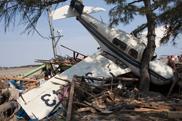 Yasuyoshi Chiba/AFP/Getty Images
Yasuyoshi Chiba/AFP/Getty Images
Which group is right?
While multiple opinions exist, there is one source that reveals the truth about disasters and the reason for their increase—the Bible.
In the book of Jeremiah, God uses His prophet to foretell calamities to come: “Disaster follows hard on disaster, the whole land is laid waste” (Jer. 4:20, RSV). The Hebrew word for “the whole land” in this passage refers to countries or the whole earth.
Natural disasters are increasingly slamming into nations, swiftly building upon each other in ways humanly devised governments are unable to manage. Think of Haiti’s massive earthquake followed by a widespread cholera outbreak. Think of the almost 200 deadly tornadoes that swept through six American states in a 24-hour period. Think of the volcano-tsunami devastation in Indonesia, which displaced 300,000 people.
In reality, the earthquake in Japan was only one disaster with many effects. The temblor produced a tsunami that destroyed buildings and homes, and left people unable to work. People’s inability to work leads to less capital for the country’s economy. A weaker economy forces employers to lay off workers. Less money leads to poverty and homelessness. Poverty leads to disease. Disease can lead to death. On and on it goes.
Yet God says such destruction will happen globally—to all countries on Earth! Imagine country after country experiencing what Japan did. Picture less-developed, cash-strapped nations brimming with civil unrest, disease and hunger facing such tragedies—but without Japan’s grace.
Across the country, Japan’s disaster-prepared people showed strength of character by helping others, and standing patiently in line for water, food and supplies. No looting. No violence.
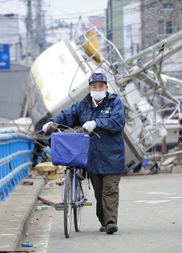 Toshifumi Kitamura/AFP/Getty Images
Toshifumi Kitamura/AFP/Getty Images
Perhaps a Japanese proverb best sums up the people’s attitude: “After the rain, earth hardens.” This means that after a storm, things will often stand more solidly than they did before. It also means, “adversity builds character.”
Few Japanese survivors carry the kind of “me-first” attitude evidenced in many other countries of the world, including all Western nations—especially in times of disaster. Consider the aftermath of Hurricane Katrina in the United States and protests resulting from austerity measures in Europe.
While Japan has been fairly successful, imagine it having to cope with another disaster of the same proportion in a different country while helping its own people recover. It would be impossible. No human government—or governments—would ever be able to deal with such crises all at once!
Yet God says the multiple disasters that crippled Japan—an earthquake, tsunami, ongoing nuclear crisis, economic troubles, health threats—are just a foretaste of far worse catastrophes to come.
As devastating as Japan’s earthquake and tsunami were, these will pale in comparison to other foretold disasters. The Bible prophesies five specific mega-earthquakes. One is shown in Revelation 16:18: “…and there was a great earthquake, such as was not since men were upon the earth, so mighty an earthquake, and so great.”
This quake will be the most powerful to occur since Creation, drastically changing Earth’s topography: “And every island fled away, and the mountains were not found” (vs. 20). It will become so bad that people will “begin to say to the mountains, Fall on us; and to the hills, Cover us” (Luke 23:30). Conditions will be so terrible that people will wish to die.
This prompts the question: why would God, the Creator, want such horror to occur?
Forgetful People
Look at modern society. It has gravitated toward trusting in material protection. It has become so complacent in its preparedness that it no longer feels it needs God to survive.
Yet God the Father, a loving parent and Creator of all life, understands man needs Him (Jer. 10:23). To help His creation, God provides an Instruction Manual showing how mankind should live. This Instruction Manual, the Bible, reveals a previously established set of rules that guide man on how to interact with others. It also provides real-life written examples to teach him valuable lessons.
One of these examples is found in Genesis. After a global flood destroyed almost all life, the descendants of the survivors began to build a high tower to protect themselves: “And they said…let us build us a city and a tower, whose top may reach unto heaven; and let us make us a name, lest we be scattered abroad upon the face of the whole earth” (Gen. 11:4). The ancient Hebrew term translated “scattered abroad” means: “to dash in pieces.” The people were afraid another flood would come, which led them to take such measures.
Although the people may have been well-intentioned, they missed the point. God expected them to rely on Him for protection. God realized that if people trusted only in themselves, it would spell destruction for them—and all generations to follow. Therefore, He confused the language of those building the tower so they could not continue: “And the Lord said, Behold, the people is one, and they have all one language; and this they begin to do: and now nothing will be restrained from them, which they have imagined to do” (11:6).
Changing the language of the builders should have served as a wake-up call. They should have realized they were weak human beings who needed God’s help. They should have turned to Him, cried out to Him, repented and served Him as it says in II Chronicles: “If My people…shall humble themselves, and pray, and seek My face, and turn from their wicked ways; then will I hear from heaven, and will forgive their sin, and will heal their land” (II Chron. 7:14).
But they did not.
Part of Life?
History shows that mankind’s natural reaction of relying on human ingenuity, and developing stronger physical protection from disasters does not work. Just as tsunami walls were not enough to save tens of thousands in Japan, humanity’s physical protective measures will eventually fail.
While you may have become conditioned to accept that disasters are a natural part of life—mere time and chance events—there is a place you can turn to seek protection. You do not have to see an earthquake or tsunami as simply “another disaster.”
“In Japan, they have a civilization of earthquake preparedness,” Pedro Silva, an engineer at George Washington University told National Public Radio. “…even at the kindergarten level, they receive earthquake briefings continuously. It’s really in their culture.”
Japan, a more developed and technologically advanced country, builds structures fortified with high-quality materials and enforces strict building codes. Trains are programmed to stop at the slightest shaking to prevent derailment. Tokyo’s Tsunami Warning Center measures seismic earthquake waves, which allows it to project where ensuing aftershocks or tsunamis might occur. Warning sirens and concrete protective seawalls are in almost all towns. Children even carry fireproof hoods in their schoolbags in case of emergency.
Disasters are an integral part of life.
Yet because the nation believes it is humanly prepared for an earthquake, after feeling initial tremors, many of its people did not immediately act, but rather viewed it as “just another earthquake.” It was not until the earth continued rocking violently for six whole minutes, and people were almost literally shaken out of buildings, that many fled to the streets.
Where to Turn
In the same way, civilization as a whole is just beginning to experience the kind of troubles foretold long ago in the Bible: “the beginning of sorrows” (Matt. 24:8). These are a type of small foreshocks designed to warn about what is coming. But as with an earthquake, soon the world will be shaken to its core. How many disasters must occur before human beings wake up?
To most, these prophesied tragedies seem cruel. Yet God is a loving parent who wants to raise His children—those He created—correctly. He wants to see them become happy and prosperous. Yet He realizes that man cannot find his own way to peace without first turning to Him and learning from Him.
As with any rebellious teenager, man thinks he knows better than God, and does not believe he needs God’s help. Therefore, God realizes He must first allow His children to learn lessons themselves by allowing certain events to occur for a short time. These will help people worldwide appreciate the coming best news for the world—Christ’s Return—when true world peace will finally be established and all people who have ever lived will have an opportunity to live as He intended. (Read Tomorrow’s Wonderful World – An Inside View!)
But by turning to God now—and following His Commandments and statutes before this time comes—you can ultimately be protected from the trouble that lies ahead. Notice: “The God of my Rock; in Him will I trust: He is my shield, and the horn of my salvation, my high tower, and my refuge, my savior; You save me from violence” (II Sam. 22:3).
The age of the ways of man—humanity’s time of self-rule, of people deciding for themselves how to live, how to behave, and how to treat their neighbors—is drawing to a close. Soon mankind will receive punishment for disobeying God.
This does not mean that you need to fear this time. Unlike the people of ancient times who trusted in a physical tower, you can turn to God, the only true spiritual “high tower,” “refuge” and “savior” for humanity.
Only by trusting and obeying Him can you fully prepare for what is coming—and be protected.
More on Related Topics:
- Two Years On, Survivors of Turkish Earthquake Still Struggle with Loss and Hardship
- What to Expect After South Korea’s Impeached President Was Indicted on Rebellion Charges
- The Discovery of Brutal Mass Graves in Syria Reveals a Legacy of Horror
- China’s Population Falls for a Third Straight Year, Posing Challenges for its Government and Economy
- What to Know About South Korean Acting President Han’s Impeachment

